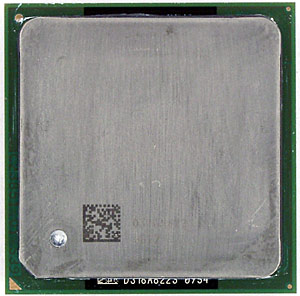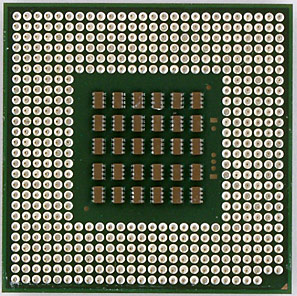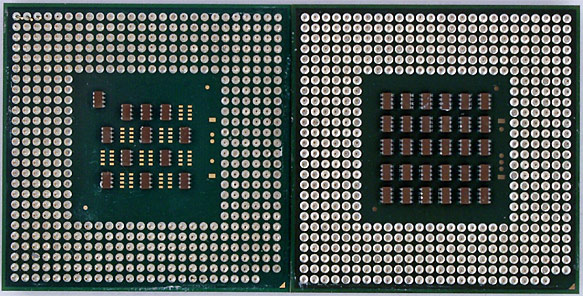 |
||
|
||
| ||
We have already reviewed one of the extreme desktop processors - the fashion that drove mad both leading x86 CPU makers. The idea originally belonged to AMD, though Intel quickly picked it up and even was first to release its Pentium 4 Extreme Edition. Both companies had the same idea in mind when designing these models: AMD says that its baby is the only processor in its class designed specially for cinematic computing and provides the powerful technology for stunning games and wonderful multimedia entertainment; Intel says that its processor allows creating realistic physical models and ensures operation of intelligence systems providing exceptional features for gamers and demanding users. In short, these processors are meant for games. However, the companies have a different attitude toward the future of their babies: Intel admits that they don't care whether the Pentium 4 EE (or XE? the processor doesn't have an official acronym) is going to be successive. In contrast, AMD is aggressively pushing the idea of the extreme desktop processor into life. Later we will see what are the grounds of both companies. First of all, let's look at the processors. What's it? A new trend in the CPU building? Special extreme solutions? Or what? First, let's see what CPU lines both companies got and what their specs are. Specification of some of Intel's and AMD's CPUs
* Maximum possible core clock for this CPU lineWell, the table shows where the Pentium 4 Extreme Edition and Athlon 64 FX originate from. Pentium 4 Extreme Edition
 It reminds an ordinary Pentium 4... The P4 EE is actually the same Xeon MP, just ported to another (desktop) socket (Socket 603 -> Socket 478). Also, it got a bus from the modern Pentium 4 (800 MHz), runs at a higher clock speed. It doesn't support SMP systems, though we can't check it as there are no SMP boards with the Socket 478! Intel could even leave the SMP supported as there's no chance to get a dual P4 EE - hardly anyone would dare to make such a board. Besides, the P4 EE supports ordinary (unregistered, without ECC) DDR400 SDRAM, so does the Xeon MP (unlike AMD K8, Intel's processors doesn't care about memory types or features). But the Xeon MP doesn't have respective boards (look at the requirements for the modules in the above example), while the P4 EE can be easily installed on desktop mainboards equipped with ordinary memory. The Pentium 4 Extreme Edition is just another Xeon MP on a different socket. It's hard to say whether the die was redesigned - I think not. It looks identical to the Pentium 4 - only the marking and back side differ.  Ordinary Pentium 4 on the left, Pentium 4 Extreme Edition on the right Athlon 64 FXIt seems that this processor is the same Opteron 100 with just a different marking. The core working at the clock higher by 200 MHz can be the result of more careful selection of the Opteron 146 samples, and the support for the registered DDR400 (instead of DDR333) was already discussed. But such a simple way of its development turns out to be its disadvantage. The Pentium 4 Extreme Edition is a pure desktop processor as it can be installed onto desktop boards and supports widespread DDR400 (PC3200). At the same time, AMD's Opteron 146 is still the Opteron, with a server socket (which requires a specific board) and support for just registered memory. It's quite a problem to find registered DDR400 modules today. The worst disadvantage of the Athlon 64 FX is that it's impossible to upgrade the Athlon 64 to the Athlon 64 FX without replacing the board and memory. At the same time, there's no such problems with the Pentium 4 with 800 MHz FSB and Pentium 4 Extreme Edition. The preliminary scores of the processors are the following: the Pentium 4 Extreme Edition gets A (it's a pure desktop processor in all respects whatever it has inside), the Athlon 64 FX gets C (they should think of its other parameters instead of just remarking it). But they probably had no choice as the desktop Socket 754, a standard for the AMD64 architecture, doesn't support processors with a dual-channel memory controller. Still, it doesn't justify AMD - they should have taken it into account beforehand. Well, let's test their performance and see what their real scores are. TestingTestbed:
Software: OS and drivers:
Test applications:
Test resultsMemory performanceThis aspect is not to be studied in this review as we examine just processors, not platforms or chipsets. However, these diagrams will help us interpret the scores in the other tests; so, the memory was tested in the Cachemem and CacheBurst32 synthetic benchmarks. There's actually nothing unexpected: in the read speed tests (Cachemem, CacheBurst32 Memory Peak Bandwidth) all processors except the Athlon 64 3200+ go on a par (it turns out that the Athlon 64 FX-51 doesn't looks stronger than the ordinary Pentium 4). In the write speed tests both extreme editions perform equally well, with the ordinary Pentium 4 falling behind them. Besides, both Athlon 64 processors with the memory controllers integrated demonstrate low latency, though the best dual-channel chipset for Intel's CPU performs worse. AMD looks advantageous and Intel will probably also reinforce its position by integrating the memory controller into the processor). Note that the single-channel Athlon 64 3200+ has a much lower latency than the dual-channel Athlon 64 FX-51. But it can be caused not just by the number of the controller channels. Remember that the FX-51 has registered, ECC memory... 3ds max 5.1While the Pentium 4 EE benefits little from the 2MB L3 cache (2%), the Athlon 64 FX-51 outscores the Athlon 64 3200+ by 10%. However, the AMD platform loses in the end: the difference between the fastest AMD system and fastest Intel system makes 10%, in favor of Intel. Such performance can be explained by the "attitude" of a certain application (3ds max) towards the platforms from two leading manufacturers. I don't think that it's worth replacing the Pentium 4 EE based system instead of the Pentium 4: the scores are not impressive, especially considering the pricetags... The Athlon 64 3200+ has nothing to boast of - it loses almost 18% even to the ordinary Pentium 4 3.2 GHz. Lightwave 7.5It seems that AMD's processors don't dig rendering. The Lightwave (taken as an alternative solution, it's not that widespread as the 3ds max) makes Intel a winner again. But remember that the Lightwave can't detect the number of processors in the system itself and leaves it for the user. You actually indicate the number of threads generated by the rendering process. There are 1, 2, 4 and 8 threads available, but it makes sense to speak only about 2 settings (at least, in x86 SMP systems) - 1 or 8 (maximum). The scores are almost identical for 2, 4 and 8 threads in case of more than one CPU. Now let's turn to the Hyper-Threading... The HT lifts performance of both Pentium 4 by 18%! Without the virtual multiprocessing the Athlon 64 FX and both Pentium 4 could have similar results, but with this technology enabled both P4 make a big jump - 22% separates the fastest Intel system from the fastest AMD. On the other hand, we don't see any benefit of the 2MB L3 cache for the Pentium 4 EE. The performance grows up by 7-8 sec. The scores of the Athlon 64 3200+ look pretty sad again as it falls behind even the regular Pentium 4 by 30%. Adobe Photoshop 7.0The Athlon 64 FX-51 looks better in dealing with raster graphics. The situation is similar to the 3ds max, with just the start conditions being different. The Athlon 64 3200+ and Pentium 4 3.2 GHz have a miserable gap between them. Their extreme editions look quite different. The Pentium 4 Extreme Edition outscores its sibling by considerable 10%, but the extreme Athlon 64 FX-51 gains 22%! Such a performance gain is achieved mostly due to the dual-channel memory controller - the clock speed can't be the only catalyst: if it were so the speed growth wouldn't be greater than the frequency growth (at least, in the x86 architecture), and here the difference between 2200 and 2000 MHz makes 10% which is far from 22%... The Athlon 64 3200+ performs quite well - it looks equal to the Pentium 4. So, if you use mostly the Photoshop you should consider the alternative platform... Note that our script for the Adobe Photoshop 7.0 doesn't include specific filters - tastes and preferences differ. The script covers operations all of the users resort to: framing, rotation at an arbitrary angle, free transform, color models transform (RGB<->CMYK) and a couple of universal filters (Unsharp Mask and Smart Blur). 7-ZipThis is a specific archiver, but it's the only archiver supporting SMP systems through a multithread compression process. It can bring benefit to the Pentium 4 due to the Hyper-Threading. The diagrams show that our expectations come true - both systems based on the Intel processors get excellent scores. However, the advantage of the extreme edition over the plain processor is again greater in case of the AMD processors: Athlon 64 FX-51 outdoes the Athlon 64 3200+ by 20%, while the gap between the Intel's processors is just 6%. Now we have the WinRAR which doesn't support multithread archiving... WinRAR...Again, different start conditions result in different final scores, with the trends being the same. The Athlon 64 FX-51 looks much faster than the Athlon 64 3200+ but in this test it just helps the AMD processor to catch up with its counterpart. Taking into account relative scores, not the absolute ones, the "Extreme Performance Edition" title should be awarded to the Athlon 64 FX-51. The difference between the Pentium 4 EE and its ordinary version is much lower. Bzip2The WinZIP and its variations are not used anymore as their performance depends mostly on the disc system speed (read/write) rather than on the CPU or memory. But the cross-platform Bzip2 is said to be quite good at compression and it's pretty popular with Linux users... However, it's impossible to avoid the influence of the disc subsystem as the number of disc operations on a 300MB files set is pretty large. Judging by the results, the Bzip2's dictionary is not big as this is the first time when the Pentium 4 Extreme Edition's cache really helps. The dictionary looks to be entirely recorded into the cache. And it's also the first time when the difference between the Intel processors is greater than that between the AMD ones. The Athlon 64 3200+ beats the Pentium 4 3.2 GHz proving that the dictionary is not great because the former also has a larger cache than the latter. Lame 3.93The audio encoding turned out to be the quietest test. The difference is minimal, the trends are hardly distinguishable; besides, the 2 MB L3 cache doesn't help the Pentium 4 EE at all. Return to Castle WolfensteinAlthough we can't imagine that someone would spend $900 only for playing games, we can't exclude games either because many think that benchmarking without games reveals nothing... Well, the tests in different resolutions in the Return to Castle Wolfenstein demonstrate that in the more or less playable modes the performance depends on a processor least of all. Hm, what can we discuss yet? Let's see what systems different engines prefer. The RtCW digs Intel, especially the Pentium 4 Extreme Edition, especially in 800x600... no, I can't write about such things anymore... :)) Serious Sam: The Second EncounterHere the CPUs' preferences are not a joke. The Serious Sam traditionally prefers AMD, and its love for the extreme edition becomes more pronounced. The difference of even 7 fps in 1280x1024 at 32bit color and high image quality is quite important. Let's see why it happens, and take almost synthetic but more demonstrative results in 800x600 pixels. The Pentium 4 EE works faster than the plain Pentium 4 by 12%, while the Athlon 64 FX-51 outscores the Athlon 64 3200+ only by 9%. What could cause such scores? Do you remember when the Pentium 4 benefits most of all from its large cache? It benefits most of all in case of a chaotic code when the branch prediction mechanism often makes mistakes. That's the very case of the Serious Sam. Some of you might remember a game with similar peculiarities which was once used in our tests... Unreal Tournament 2003The same Expendable syndrome! It' only Id Software which can write a smooth code which greatly affects Intel's processors. Do they use different compilers? Anyway, if we look again what engines the processors prefer, AMD will look better again. And again, in high resolutions! The guys at Epic Games should definitely master Intel's optimization compilers :) By the way, in the Unreal Tournament 2003 and Serious Sam the plain desktop AMD Athlon 64 3200+ beats all Intel's processors including the Pentium 4 Extreme Edition! But maybe the reason is different. Games are getting more complicated, and complexity doesn't easily go with the linear code. Among three game engines the RtCW which prefers the Pentium 4 is the oldest. Both new engines prefer AMD. But this is just an assumption. When the Intelophiles release the final Doom 3, we will make the final conclusion. ConclusionTaking into account the number of the processors compared, we decided to divide the summary into several parts within which we will discuss the most probable competitors because people usually choose not among 4, 5, 6 processors but bring the number of candidates to a couple. The test results are recombined - now you can see on the same diagram all the benchmarks for two competitors, with the performance of one of them taken for 100%. You can consider such representation a trial - if you like it, we can adopt it. Pentium 4 Extreme Edition vs Pentium 4The gap is just 8.5%, especially considering that the Bzip2 archiver makes the greatest contribution... The impression about the Pentium 4 Extreme Edition are somewhat vague. Its 2MB L3 cache hardly helps it, we expected a greater advantage. The way Intel positions this processor is completely correct. However, in some applications its performance reaches a good level. That is why you should consider it if it really reaches such heights in your favorite applications. Athlon 64 FX-51 vs Athlon 64 3200+We mentioned already that the Extreme Performance Edition title should be awarded exactly to the 64 FX-51, and the diagram proves it. It's not just because of the average performance gain which is higher in case of AMD, but also because the Athlon 64 FX-51 is always noticeably faster than the Athlon 64 3200+, compared to the P4 EE and its sibling. The higher clock speed of the "half-server" AMD processor also contributes to the performance, but the frequency growth (which makes 10% for Athlon 64 3200+ and Athlon 64 FX-51) is lower than the performance gain, that is why there are other factors influencing the acceleration, 4 in all. The only disappointing fact about AMD is that it's not easy to upgrade the processor. Athlon 64 3200+ vs Pentium 4 3.2 GHzThe 6% gap is not a defeat yet, especially because the AMD outscores its competitor in 4 cases out of 10. However, it looks best of all in games, where top CPUs are rarely used. As you can see the Athlon 64 3200+ performs worst of all in 3ds max, Lightwave, and 7-Zip - the applications which can take advantage of multiprocessing. That is why we can consider that the Pentium 4 wins at the expense of the Hyper-Threading support. Just look again at the Lightwave diagrams and compare the results for one and eight threads - the Athlon 64 3200+ is not so far behind in case of one thread compared to eight threads. Whatever AMD says, facts remain facts: the multiprocessing emulation turned out to be a very useful tool for at least for the Pentium 4. Athlon 64 FX-51 vs Pentium 4 Extreme Edition 3.2 GHz, or simply AMD vs. Intel :)Well, the battle of the most powerful desktop processors from both leading CPU makers reveals no winners. We can't admit that the Pentium 4 Extreme Edition wins at the difference of 1.3%, especially because the P4 EE wins in half of the tests, while the A64 FX takes the crown in the other half. Such battle makes me smile again. The companies have been fighting for years and none of them can take the lead, in spite of new architectures, hyper-threading, 64bit instructions etc. Isn't it a sign to stop the race? But none would listen to us... Athlon 64 FX-51 vs Pentium 4 3.2 GHz?Well, it definitely looks superior :), otherwise it didn't make sense for AMD to release such processor. I think that the decision to release it was based on the test results of this couple. But the price is too high: server boards (or at least, workstation boards), registered DDR400 which is hard to find... The victory is not that impressive, and the competitor turned out to be different - they were going to fight against the plain Pentium 4, but Intel quickly baked the extreme edition. Users might get such extreme processors either if they are mad about
one or the other company, or if they need a PC for definite applications
where these processors look advantageous. The rest would do with the ordinary
Pentium 4 or Athlon 64. Thankfully, none of them can unconditionally be
considered a winner.
Write a comment below. No registration needed!
|
Platform · Video · Multimedia · Mobile · Other || About us & Privacy policy · Twitter · Facebook Copyright © Byrds Research & Publishing, Ltd., 1997–2011. All rights reserved. |